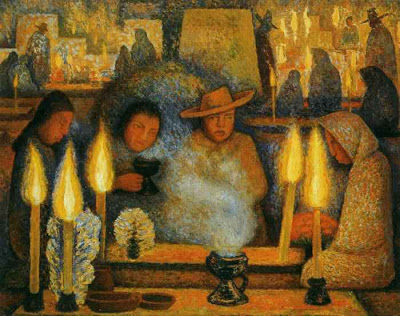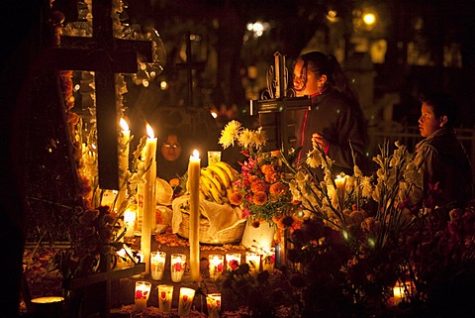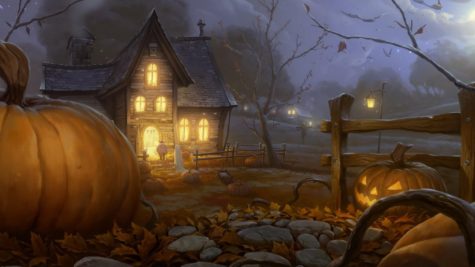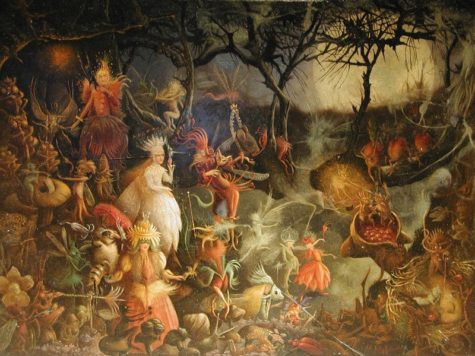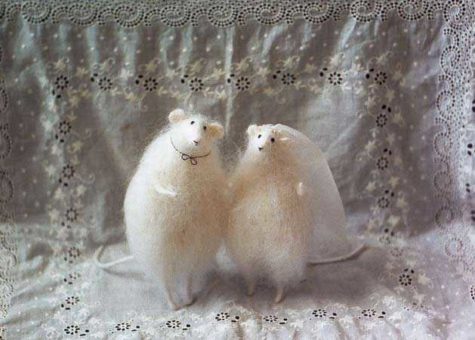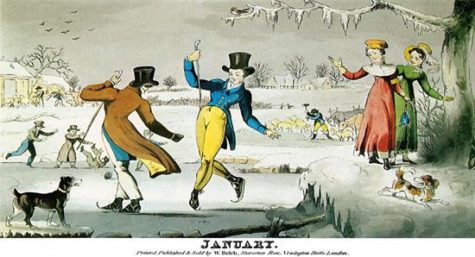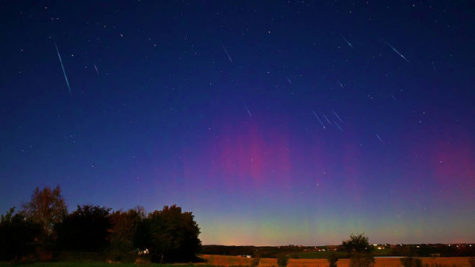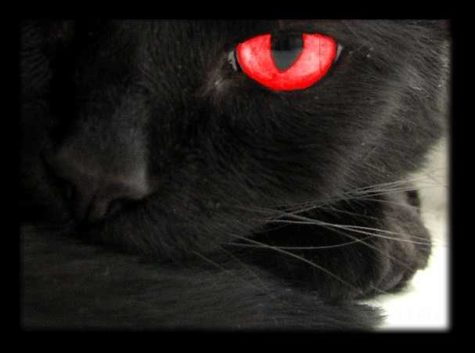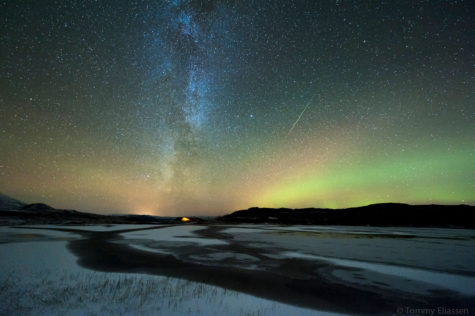Monthly Archives: October 2016
Although it’s customary in many traditions to spend time at the grave site, cleaning, caring, and sometimes bringing offerings of food and drink, particularly during Day of the Dead celebrations, (or any of other days specifically set aside to honor the dead), a more direct method was used in ancient Greece.
Create a blend of olive oil, honey, and spring water. This may be poured directly onto the grave, or poured through a tube into the grave. Meanwhile the living should picnic nearby while sharing remembrances of the deceased.
The Day of the Dead (El Día de los Muertos in Spanish) is a Mexican and Mexican-American celebration of deceased ancestors which occurs on November 1 and November 2, coinciding with the similar Roman Catholic celebrations of All Saints’ Day and All Souls’ Day.
While it is primarily viewed as a Mexican holiday, it is also celebrated in communities in the United States with large populations of Mexican-Americans, and to a lesser extent elsewhere in Latin America.
Despite the morbid subject matter, this holiday is celebrated joyfully, and though it occurs at the same time as Halloween, All Saints’ Day, and All Souls’ Day, the mood of The Day of the Dead is much lighter, with the emphasis on celebrating and honoring the lives of the deceased, rather than fearing evil or malevolent spirits.
HISTORY OF DAY OF THE DEAD
The origins of the celebration of The Day of the Dead in Mexico can be traced back to the indigenous peoples of Latin America, such as the Aztecs, Mayans Purepecha, Nahua and Totonac.
Rituals celebrating the lives of dead ancestors had been performed by these Mesoamerican civilizations for at least 3,000 years. It was common practice to keep skulls as trophies and display them during rituals to symbolize death and rebirth.
The festival which was to become El Día de los Muertos fell on the ninth month of the Aztec Solar Calendar, near the start of August, and was celebrated for the entire month. Festivities were presided over by the goddess Mictecacihuatl, known as the “Lady of the Dead”. The festivities were dedicated to the celebration of children and the lives of dead relatives.
When the Spanish Conquistadors arrived in Central America in the 15th century they were appalled at the indigenous pagan practices, and in an attempt to convert the locals to Catholicism moved the popular festival to the beginning of November to coincide with the Catholic All Saints and All Souls days. All Saints’ Day is the day after Halloween, which was in turn based on the earlier pagan ritual of Samhain, the Celtic day and feast of the dead. The Spanish combined their custom of Halloween with the similar Mesoamerican festival, creating The Day of the Dead.
DAY OF THE DEAD TRIVIA
The souls of children are believed to return first on November 1, with adult spirits following on November 2.
Plans for the festival are made throughout the year, including gathering the goods that will be offered to the dead. During the period of October 31 and November 2 families usually clean and decorate the graves. Some wealthier families build altars in their homes, but most simply visit the cemeteries where their loved ones are buried and decorate their graves with ofrendas, or offerings. These include:
- wreaths of marigold, which are thought to attract the souls of the dead toward the offerings
- toys brought for dead children (los angelitos, or little angels)
- bottles of tequila, mezcal, pulque or atole for adults.
Ofrendas are also put in homes, usually with foods and beverages dedicated to the deceased, some people believe the spirits of the deceased eat the spirit of the food, so after the festivity, they eat the food from the ofrendas, but think it lacks nutritional value.
In some parts of Mexico, like Mixquic, people spend all night beside the graves of their relatives.
Those gifted, like to write “calaveras”, these are little poems that mock epitaphs of friends. Newspapers dedicate “Calaveras” to public figures, with cartoons of skeletons. Theatrical presentations of “Don Juan Tenorio” by José Zorrilla (1817-1893) are also traditional on this day.
A common symbol of the holiday is the skull, which celebrants represent in masks called calacas. Sugar skulls, inscribed with the names of the deceased on the forehead, are often eaten by a relative or friend. Other special foods for El Día de los Muertos includes Pan de Muertos (bread of the dead), a sweet egg bread made in many shapes, from plain rounds to skulls and rabbits.
Source: Wikipedia
Halloween or All Hallow’s Eve occurs on October 31, and originated with the ancient Celts, who, beginning at sundown on October 31 and extending into November 1, celebrated Samhain (pronounced sow-in, which rhymes with cow-in), which marked the end of harvest time and the beginning of the new year. The ancient Celts believed that at this time, the veil between the worlds of the living and the dead was at its thinnest, thereby making it a good time to communicate with the deceased and to divine the future.
In later years, the Irish used hollowed-out, candlelit turnips, carved with a demon’s face to frighten away the spirits. When Irish immigrants in the 1840s found few turnips in the United States, they used the more plentiful pumpkins instead.
Halloween activities include:
- Trick-or-treating (going door to door in costume and asking for treats)
- Attending Halloween costume parties
- Decorating, carving pumpkins into jack-o’-lanterns
- Lighting bonfires
- Apple bobbing
- Divination games
- Playing pranks
- Visiting haunted attractions
- Telling scary stories and watching horror films.
In many parts of the world, the Christian religious observances of All Hallows’ Eve, including attending church services and lighting candles on the graves of the dead, remain popular, although elsewhere it is a more commercial and secular celebration. Some Christians historically abstained from meat on All Hallows’ Eve, a tradition reflected in the eating of certain foods on this vigil day, including apples, potato pancakes and soul cakes.
Related Content:
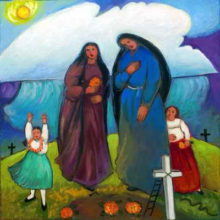 Honoring the dead occurs in ancient cultures all over the world, and even in modern times it plays an important role in religions. It is founded on the belief that the dead live on and are able to influence the lives of later generations. These ancestors can assert their powers by blessing or cursing, and their worship is inspired by both respect and fear. Rituals consist of praying, presenting gifts, and making offerings. In some cultures, people try to get their ancestors’ advice through oracles before making important decisions.
Honoring the dead occurs in ancient cultures all over the world, and even in modern times it plays an important role in religions. It is founded on the belief that the dead live on and are able to influence the lives of later generations. These ancestors can assert their powers by blessing or cursing, and their worship is inspired by both respect and fear. Rituals consist of praying, presenting gifts, and making offerings. In some cultures, people try to get their ancestors’ advice through oracles before making important decisions.
The dead are believed by the peasantry of many Catholic countries to return to their former homes on All Souls’ Night and partake of the food of the living. In Tyrol, cakes are left for them on the table and the room kept warm for their comfort. In Brittany, people flock to the cemeteries at nightfall to kneel, bareheaded, at the graves of their loved ones, and to anoint the hollow of the tombstone with holy water or to pour libations of milk on it. At bedtime, the supper is left on the table for the souls. In Bolivia, many people believe that the dead eat the food that is left out for them. Some claim that the food is gone or partially consumed in the morning.
The Day of the Dead celebrations in Mexico and other countries can be traced back to the indigenous peoples such as the Olmec, Zapotec, Mixtec, Mexican, Aztec, Maya, P’urhépecha, and Totonac. Rituals celebrating the deaths of ancestors have been observed by these civilizations perhaps for as long as 2500–3000 years. In the pre-Hispanic era, it was common to keep skulls as trophies and display them during the rituals to symbolize death and rebirth.
The festival that became the modern Day of the Dead fell in the ninth month of the Aztec calendar, about the beginning of August, and was celebrated for an entire month. The festivities were dedicated to the goddess Mictecacihuatl, known as the “Lady of the Dead,” corresponding to the modern Catrina.
In most regions of Mexico, November 1st honors deceased children and infants where as deceased adults are honored on November 2nd. This is indicated by generally referring to November 1st mainly as “Día de los Inocentes” (Day of the Innocents) but also as “Día de los Angelitos” (Day of the Little Angels) and November 2nd as “Día de los Muertos” or “Día de los Difuntos” (Day of the Dead).
Many people believe that during the Day of the Dead, it is easier for the souls of the departed to visit the living. People will go to cemeteries to communicate with the souls of the departed, and will build private altars, containing the favorite foods and beverages, and photos and memorabilia, of the departed. The intent is to encourage visits by the souls, so that the souls will hear the prayers and the comments of the living directed to them. Celebrations can take a humorous tone, as celebrants remember funny events and anecdotes about the departed.
Plans for the festival are made throughout the year, including gathering the goods to be offered to the dead. During the period of November 1 and November 2, families usually clean and decorate graves; most visit the cemeteries where their loved ones are buried and decorate their graves with ofrendas, or offerings, which often include orange marigolds called “cempasúchitl.” In modern Mexico this name is often replaced with the term “Flor de Muerto” (“Flower of the Dead”). These flowers are thought to attract souls of the dead to the offerings.
Toys are brought for dead children (los angelitos, or little angels), and bottles of tequila, mezcal, pulque or atole for adults. Families will also offer trinkets or the deceased’s favorite candies on the grave. Ofrendas are also put in homes, usually with foods such as candied pumpkin, pan de muerto (“bread of the dead”) or sugar skulls and beverages such as atole. The ofrendas are left out in the homes as a welcoming gesture for the deceased. Some people believe the spirits of the dead eat the “spiritual essence” of the ofrenda food, so even though the celebrators eat the food after the festivities, they believe it lacks nutritional value. Pillows and blankets are left out so that the deceased can rest after their long journey. In some parts of Mexico, such as the towns of Mixquic, Pátzcuaro and Janitzio, people spend all night beside the graves of their relatives.
Some families build altars or small shrines in their homes. These altars usually have the Christian cross, statues or pictures of the Blessed Virgin Mary, pictures of deceased relatives and other persons, and scores of candles. Traditionally, families spend some time around the altar praying and telling anecdotes about the deceased. In some locations, celebrants wear shells on their clothing so when they dance the dead will wake up because of the noise. Some will dress up as the deceased.
Public schools at all levels build altars with offerings, usually omitting the religious symbols. Government offices usually have at least a small altar, as this holiday is seen as important to the Mexican heritage.
Those with writing talent sometimes create short poems, called “calaveras” (“skulls”), mocking epitaphs of friends, sometimes describing interesting habits and attitudes or some funny anecdotes. This custom originated in the 18th-19th century, after a newspaper published a poem narrating a dream of a cemetery in the future, “and all of us were dead”, proceeding to “read” the tombstones. Newspapers dedicate calaveras to public figures, with cartoons of skeletons in the style of José Guadalupe Posada, a Mexican illustrator. Theatrical presentations of Don Juan Tenorio by José Zorrilla (1817–1893) are also traditional on this day.
Island Pacanda, Lake Patzcuaro Mexico – Dia de los MuertosA common symbol of the holiday is the skull (colloquially called calavera), which celebrants represent in masks, called calacas (colloquial term for “skeleton”), and foods such as sugar skulls, which are inscribed with the name of the recipient on the forehead. Sugar skulls are gifts that can be given to both the living and the dead. Other holiday foods include pan de muerto, a sweet egg bread made in various shapes, from plain rounds to skulls and rabbits often decorated with white frosting to look like twisted bones.
José Guadalupe Posada created a famous print of a figure that he called “La Calavera de la Catrina” (“calavera of the female dandy”), as a parody of a Mexican upper class female. Posada’s striking image of a costumed female with a skeleton face has become associated with the Day of the Dead, and Catrina figures often are a prominent part of modern Day of the Dead observances.
The traditions and activities that take place in celebration of the Day of the Dead are not universal and often vary from town to town. For example, in the town of Pátzcuaro on the Lago de Pátzcuaro in Michoacán the tradition is very different if the deceased is a child rather than an adult. On November 1 of the year after a child’s death, the godparents set a table in the parents’ home with sweets, fruits, pan de muerto, a cross, a Rosary (used to ask the Virgin Mary to pray for them) and candles. This is meant to celebrate the child’s life, in respect and appreciation for the parents. There is also dancing with colorful costumes, often with skull-shaped masks and devil masks in the plaza or garden of the town. At midnight on November 2, the people light candles and ride winged boats called mariposas (Spanish for “butterfly”) to Janitzio, an island in the middle of the lake where there is a cemetery, to honor and celebrate the lives of the dead there.
In contrast, the town of Ocotepec, north of Cuernavaca in the State of Morelos opens its doors to visitors in exchange for ‘veladoras‘ (small wax candles) to show respect for the recently dead. In return, the visitors receive tamales and ‘atole‘. This is only done by the owners of the house where somebody in the household has died in the previous year. Many people of the surrounding areas arrive early to eat for free and enjoy the elaborate altars set up to receive the visitors from ‘Mictlán‘.
In some parts of the country, children in costumes roam the streets, asking passersby for a calaverita, a small gift of money; they don’t knock on people’s doors.
Some people believe that possessing “dia de los muertos” items can bring good luck. Many people get tattoos or have dolls of the dead to carry with them. They also clean their houses and prepare the favorite dishes of their deceased loved ones to place upon an altar.
Collected from various sources.
The celebrations on the eve of All Souls Day, called Halloween, (October 31), stem from the Celtic New Year celebration called Samhain. When the Sun goes down on this eve, there is a time between the old year and the creation of the new. Specifically, this occurs at sunrise.
In this twilight of the years, the veil between this world and the world of the spirit is thin. It is a time when ghosts and spirits can interact with the living, and a time when divination is most effective. This is a sacred time when all warriors were to keep their swords sheathed.
Samhain literally means “end of the summer.” This day marked the last harvest of the summer, and so it is a harvest celebration. But, because there were only three months in the ancient Celtic calendar, and no autumn, it is also the beginning of the winter death that will lead to next year’s regeneration.
Ancient Celts believed that at Samhain, the veil between the worlds of the living and the dead was extremely thin, allowing the dead to cross over into the world of the living. Sometimes they appeared as apparitions and sometimes in the form of animals, most particularly black cats. The living lit bonfires and dressed in costumes to confuse the spirits and keep them from re-entering the world. On this night, the lord of death reigns, and the Celts protect themselves from this threat with bonfires and animal sacrifice. Animal sacrifice is closely associated with divination.
In most ancient cultures, the remains of the sacrificed animal were examined to discover the will of the gods and to predict the future. The Druid priests would take advantage of this auspicious time to look into the events of the upcoming year—at least up until Beltane, which marked the year’s midpoint.
Although predicting the future is not necessarily the best use of the tarot, this is a good time to try reading the future. You can do this by laying out three cards for each of the six months from Samhain to Beltane (you should have eighteen total cards). Read each set of three cards as a story that will pertain to that month.
During the period of Samhain, the time when the world of the living is closest to the world of the dead, it is often a good idea to make offerings to the spirits to keep them from doing harm. Traditionally on Halloween night, gifts of milk and barley are left out beneath the stars to acquire the blessings of ghosts and prevent them from harming your household.
Other traditions involve leaving a plate of food outside the home of the souls of the dead. A candle placed in the window guides them to the lands of eternal summer, and burying apples in the hard-packed earth “feeds” the passed ones on their journey.
For food, beets, turnips, apples, corn, nuts, gingerbread, cider, mulled wines and pumpkin dishes are appropriate, as are meat dishes.
It’s also told that the Fairy Folk became very active during Samhain, pulling pranks on unsuspecting humans. People use to dress in white (like ghosts), wear disguises made of straw, or dress as the opposite gender in order to fool the spirits and traveling after dark was was not advised. The holiday’s bonfires and glowing turnips (yes, turnips) helped the dead on their journey while protecting the living.
Magick is in the air, and it’s important to just let things happen. Keep good fun thoughts in your mind, with hope for the future. These positive thoughts will turn into Magick energy and be released… that is the power of Samhain!
Here are 5 ways to celebrate Samhain:
1. Honor the dead
Honoring the dead is one of the best ways to create Magick on Samhain. How do you honor the dead? By remembering them. Think of all the people that have passed on in your life, and don’t let their memories fade. Spend some time looking through old photographs. Think deeply about what they were like in life, what did they do… what did they feel? Tell them you miss them. Tell them you love them. Talk about them to friends and family.
2. Have a “dumb” supper
Pick a person (alive or passed away) that has qualities you admire… maybe someone you love and care about that isn’t with you. Have dinner as usual, but leave an empty plate for them and “pretend” they are there.
You can either talk to them…ask them how they are doing. Or you can have dinner in complete silence, and think about them deeply. Treat your “guest” with a delicious meal, some good wine, and a tasty dessert. The person you are honoring will feel the energy, and you’ll boost your emotional and Magick sources.
3. Carve a pumpkin
Pumpkin carving is a pagan pastime. It actually has it’s roots in the belief that carving faces into turnips would keep evil away. Pumpkins work just as well and are easier to carve. Yes, it’s fun, and it will also keep any bad luck and negative energy away.
4. Feast… feast… feast!
This is one of the best ways to celebrate Samhain because the positive emotions that build up will directly influence the effects of your divinations and rituals. If you have like-minded friends or family, get together and make a feast! There are many special recipes that work wonders for enhancing your Magick…
5. Do your Divinations
This is the BEST time of the year for seeing what is to come…and don’t let it pass by without doing at least one divination ritual. You could do Tarot, Runes, Scrying, Pendulum divination, Tea Reading, and any other divination techniques that resonate with you. It’s best to do your divinations AFTER the feast because that’s when the energy is at it’s peak.
Note: Information collected from Robert Place, Rose Ariadne, and various other sources.
Another Note: You can find more posts of interest by exploring the following links…
This ritual is linked to chasing away mice from the house and village and is observed on different days in different areas. In many places, this coincides with the Day of Martyr Nestor of Thessalonica, (October 27), or the day after the Day of the Archangel Michael (November 8th).
On this day, no one should utter the word ‘mouse,’ lest.they hear their name and decide that they have been invited to stay at or come to your house. This day is traditionally honored by women. No household work is done, so that mice do not harm the house or the grain. Skirts are sewn up the front and the back as a symbolic “sewing up” of the mice’s eyes. Fireplaces might also be (temporarily) sealed, so that the eyes and mouths of the mice are similarly covered.
Then the Mice Wedding is performed. Calling them “lad” and “lady”, a male and a female mouse are dressed as bride and groom and married in a ritual typical to a human wedding of the region. They are then placed in a basket and marched through the village in a solemn procession, The newly weds are then taken far as away from the village where they are set free, or more commonly, taken to the river and ceremonially drowned.
The idea being that the other mice in the village would be inspired to follow the procession out of the village. Marriage was the most common cause of a change in place to live, and by all means a wedding is the prerequisite for establishing a new home and a new family. Alternatively, the other mice would be so frightened by the sudden drowning of the happy couple that they would never return to the village.
If however, despite the ritual performed on Mice’s Day, the little rodents still managed to breed in hordes, it was considered a sign that someone was secretly stealing something away from the household, either food or household items. And in most cases suspicion fell on daughters-in-law and young farmhands who were not blood relations.
A cautionary tale:
Once a married man was taking away more items and clothes on the sly to give them to his mistress. Once his wife found out about the betrayal, she took the matter to the judge. The judge summoned the disloyal husband and demanded an explanation. The man denied the whole time, until finally the wounded wife blurted out the last and uncontested proof, namely that the mice in the house had bred in unusually high numbers. Then the cheating husband admitted his shame and confessed he was taking those gifts to another woman.
Another common explanation of the phenomenon of mice that continued to breed was that the family members were in discord, either daughters-in-law quarreled with one another, or refused to respect their father and mother-in-law, or possibly, the sons did not obey their own fathers’ will.
Collected from various sources
January starts the year with a plethora of fun, frolicsome festivity. The new year in particular is celebrated by at least 170 nations. In terms of energy, January focuses on beginnings. It’s a time for personal renewal, starting any beloved project, and sustaining those things already in progress.Magic for health, protection, and prosperity is particularly augmented by working during this month. It’s also good time for spell work having to do with beginning and conceiving; protection; reversing spells; conserving energy by working on personal problems that involve no one else; getting your various bodies to work smoothly together for the same goals.
Weather Watching:
It is said that whatever the weather is like the first twelve days of January indicates what the weather will be like for the next twelve months. Each day equals one month in succession.
January Birth Signs
(Celtic, Nordic, Astrological, etc)
- Dec 22 to Jan19 – Sun in Capricorn
- Dec 22 to Jan 21 – Sign of the Carnation Flower
- Dec 23 to Jan 1 – Sign of the Apple Tree
- Dec 24 – Jan 21 – Sign of the Birch Tree
- Jan 1 to Jan 11 – Sign of the Fir Tree
- Jan 12 to Jan 24 – Sign of the Elm Tree
- Jan 21 and Feb 19 – Sign of the Orchid Flower
- Jan 21 to Feb 19 – Sun in Aquarius
- Jan 21 – Feb 17 – Sign of the Rowan Tree
- Jan 25 to Feb 3 – Sign of the Cypress Tree
January – the month of new beginnings. January was introduced into the Roman calendar by a legendary king of Rome, Numa Pompilius (c. 715 – 673 BCE), who named it in honor of Janus, the god of doors and openings, beginnings and endings.
Since January is reckoned as the first month of a new year, this connection with the god Janus is appropriate. It is an excellent time to work on putting aside the old and outdated in one’s personal life and making plans for new and better conditions.
The Draconids is a minor meteor shower producing only about 10 meteors per hour. It is produced by dust grains left behind by comet 21P Giacobini-Zinner, which was first discovered in 1900. The Draconids is an unusual shower in that the best viewing is in the early evening instead of early morning like most other showers. The shower runs annually from October 6-10. Best viewing will be in the early evening from a dark location far away from city lights. Meteors will radiate from the constellation Draco, but can appear anywhere in the sky.
Source: SeaSky
According to the old roman calendar July 18 is a “dies ater” or black day, meaning a day of ill omen, or Day of Bad Omens. It marks the defeat of the Romans by the Gauls in the Battle Allia in 390 BC which in turn lead to the sack of Rome by the Gauls.
October 6 is also a “dies ater” or black day as it marks the anniversary of the battle of Arausio (105 BC).
Not much is said about the dos and don’ts or any rituals associated with either day, So, I thought it would be appropriate to post this excerpt from a little book called Signs Omens and Portents in Nebraska Folklore, published in 1933:
Signs of evil portent are among the most common of surviving folk beliefs in Nebraska. In number and currency they rival the popular omens concerned with weather and marriage and they are regarded with perhaps a greater degree of seriousness than signs of the latter type. Such a mass of superstitions having to do with death and bad luck hints at underlying pessimism in human beings. It suggests a preoccupation with the idea of death and a constant dread of inevitable calamity.
Possibly thoughts of melancholy are not so pervasive as the signs might lead us to believe, and it is reassuring to note that open credulity has almost disappeared. The mere survival of the signs, however, is a poignant reminder of a fear-ridden past, and such modern taboos as those against counting cars in a freight train and turning in a funeral car are evidence that superstitions are still in the making.
There is much confusion in the signs. Those which are regarded as bad luck omens by many people have become portents of death to others. The shift may be the result of a natural tendency to make omens specific rather than to leave them merely general indications of good or ill fortune.
Many of the signs seem to be based on a rather obvious association of ideas. Funerals bring to mind the common fate of man. Almost any incident connected with a burial may be looked upon as a sign of another death or an impending disaster. The hooting of an owl has an ominous sound. It causes a shudder, inspires fear, and becomes linked with thoughts of future afflictions. Although the howling dog may not as in legend see the goddess of death, he wakens with his mournful falsetto thoughts of gloom, and quite naturally may become to the superstitious a messenger of approaching distress.
Other signs indicate the connection between ignorance and fear, the tendency to look with dread upon the unknown, and to find in the unusual cause for anxiety. The most commonplace occurrence may become a menace, if it takes place at an unexpected time. When standards of appropriateness are violated, when the incongruous is noted, suspicion and fear are aroused.
In such signs the psychological basis seems obvious enough. In others the roots of belief are more difficult to suggest. Possibly the Romans are responsible for many omens associated with birds; the belief in the ill luck attendant upon salt-spilling may come from the Jewish and pagan use of salt in sacrificial rites, and the fear inspired by breaking a mirror may be traced to the use of mirrors by magicians in sorcery. But the origin of many of the symbols seems lost to us entirely. Like the events they predict, they are obscure, and they are perhaps more interesting because of the element of mystery which surrounds them.
The Orionids is an average meteor shower producing up to 20 meteors per hour at its peak. It is produced by dust grains left behind by comet Halley, which has been known and observed since ancient times. The shower runs annually from October 2 to November 7. Best viewing will be from a dark location after midnight. Meteors will radiate from the constellation Orion, but can appear anywhere in the sky.
Source: SeaSky
